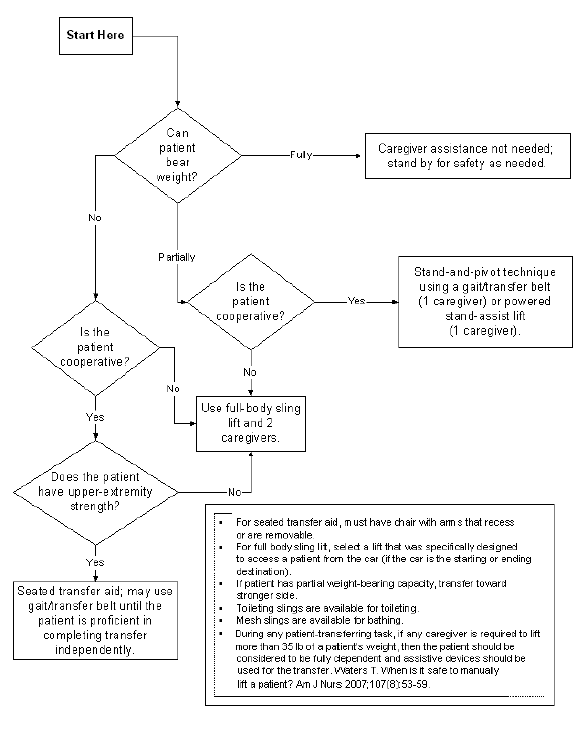Word Version [  - 61.22 KB]
- 61.22 KB]
Background: This tool is a clinical pathway that illustrates appropriate application of safe patient handling principles, which are part of universal fall precautions (described in more detail in section 3).
Reference: Developed by VA Sunshine Healthcare Network (VISN 8) Patient Safety Center of Inquiry, Tampa, Florida.
How to use this tool: Use this and other safe patient handling pathways available at: www.visn8.va.gov/VISN8/PatientSafetyCenter/safePtHandling/SafePatientHandlingAssessment_Algorithms_121112.doc as a guideline to compare against your current care processes for safe patient handling. Additional training on safe patient handling for frontline staff is available from the Centers for Disease Control and Prevention at www.cdc.gov/niosh/docs/2009-127/default.html.
This tool can be used by the nurse manager, staff nurses, and nursing assistants as an aid in designing a new system, as a training tool, or as an ongoing clinical reference tool. This tool can be modified or a new one created to meet the needs of your particular setting.

[D] Text Description: A flowchart shows the following steps: Can patient bear weight? If fully, caregiver assistance not needed; stand by for safety as needed. If partially, is the patient cooperative? If yes, stand-and-pivot technique using a gait/transfer belt (one caregiver) or powered stand-assist lift (one caregiver). If no, use full-body sling lift and two caregivers. If patient cannot bear weight, see if patient is cooperative. If no, use full-body sling lift and two caregivers. If yes, does the patient have upper-extremity strength? If no, use full-body sling lift and two caregivers. If yes, seated transfer aid; may use gait/transfer belt until the patient is proficient in completing transfer independently. If seated transfer aid, must have chair with arms that recess or are removable. For full body sling lift, select a lift that was specifically designed to access a patient from the car (if the car is starting or ending destination). If patient has partial weight-bearing capacity, transfer toward strong side. Toileting slings are available for toileting. Mesh slings are available for bathing. During any patient-transferring task, if any caregiver is required to lift more than 35 lb of a patient's weight, then the patient should be considered to be fully dependent and assistive devices should be used for the transfer.
Source: Waters T. When is it safe to manually lift a patient? Am J Nurs 2007;107(8):53-59.
Return to Roadmap
Return to Contents
Proceed to Next Section



